|
Fantasy Football Strategy, Advice, and Commentary |
|

 By: Dave Stringer — July 13, 2011 @ 10:13 am By: Dave Stringer — July 13, 2011 @ 10:13 am
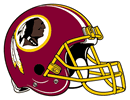
At this point, all indications are that Beck is head coach Mike Shanahan’s preferred option as the team’s starting quarterback entering training camp. The former second-round pick’s entire body of work consists of five games with the Dolphins during his rookie season in 2007. In his four starts, he struggled with accuracy and failed to throw a touchdown pass. That means two things: Beck performed well in practices, and Shanahan is dead set against going with Donovan McNabb or Rex Grossman, the top two quarterbacks on the depth chart from a year ago. Since Beck hasn’t played much, it’s hard to predict how well he will perform, assuming he starts in Week 1. However, since he hasn’t thrown a pass over the past three seasons and has already been dumped by two teams (the Ravens also gave up on him), his prognosis for 2011 isn’t good. He’s strictly an option for 14-team leagues. And even then, it’s difficult to recommend him. You can do better.
Last year, the Redskins were expected to use a combination of veterans to man the running back position, with Clinton Portis, Larry Johnson, and Willie Parker in the mix. Sitting at the back of the depth chart was the largely overlooked, former Bronco (and Mike Shanahan) draft pick in Torain. Sure enough, he became Shanahan’s new pet project and emerged as the Redskins’ top running back. Despite playing in just ten games and only starting eight, Torain finished the year with 742 rushing yards, 125 receiving yards, and six touchdowns. However, with a lengthy injury history (including four missed games last season due to hamstring problems), Shanahan chose to supplement the backfield depth chart through the draft, selecting Roy Helu in the fourth round and Evan Royster in the sixth. That means Torain will have to fight to retain his starting spot in 2011. Look for him to hold off the rookies at least for the early part of the season. Because of Helu’s presence, Torain will likely be drafted lower than he should be, but he will offer solid value if he can hold off the rookie.
With an injury-prone starter in Ryan Torain and a top backup better suited to third-down duties in Keiland Williams, the Redskins drafted Helu in the fourth round. Look for the Nebraska rookie to challenge for playing time out of the gate, provided he picks up the blitz protection schemes. However, Torain played well in 2010 and figures to hold off the rookie early in the season. Helu possesses better-than-average size at 6’0”, 220 pounds and has good speed, timing out at 4.42 seconds over 40 yards. He is a one-cut runner whose style fits well in Shanahan’s rushing attack. But the knock on him coming out of college is that he lacks lateral agility. Helu is worthy of a late-round flier in redraft leagues and as a low-end first-round pick in dynasty rookie drafts.
After struggling in 2009, Moss had a productive campaign last season as he was once again the Redskins’ leading receiver. With the team lacking depth at the position and playing from behind regularly, Moss was targeted a career-high 145 times, catching 93 passes (also a career high) for 1,115 yards and six touchdowns. Even at 31 years old, Moss still possesses nice deep speed. He was also remarkably consistent in 2010, which has been a knock against him for much of his career. He hit double-digit fantasy points six times and had a reasonable four games with five or fewer points. With Anthony Armstrong emerging last season and the team high on rookie third-round pick Leonard Hankerson, there is a strong possibility that Moss will see his target count reduced. He produced as a mid-tier WR2 last season, but that isn’t likely to happen again in 2011. Draft him as a WR3 and hope the target count stays high.
An afterthought entering the season, Armstrong quickly emerged as the Redskins’ best option starting opposite Santana Moss and established himself as the team’s big-play threat. Despite being 27 and never having caught a pass in the league, Armstrong finished the season with 44 receptions for 871 yards and three touchdowns. His 19.8 yards-per-reception average was good enough to finish third in the league in that category, behind only DeSean Jackson of the Eagles and the Steelers’ Mike Wallace—not bad company to keep. Armstrong will have to battle rookie third-round pick Leonard Hankerson to retain his spot in the starting lineup, but he seems like a safe bet when considering the shortened offseason, which will affect rookies more than veterans. Draft Armstrong as a WR4 with upside for 2011.
The Redskins used a third-round pick to acquire Hankerson in the hopes that he can shore up the team’s depth chart at wide receiver. Hankerson was productive in college at Miami and has solid size at 6’2” and 209 pounds to go along with his excellent speed. He should get a decent opportunity as a rookie as he fits in as well with the diminutive Santana Moss and deep threat Anthony Armstrong. However, the shortened offseason will hurt his chances of producing early. The best-case scenario for Hankerson is that he emerges by midseason, pushing Armstrong to the bench and showing enough for Redskins management to envision him as their top receiver in the coming seasons. Monitor his preseason progress, but at this point he ranks as a late-round flier in most leagues and waiver wire material in leagues with small rosters. He is a great option in dynasty leagues, however.
After suffering an ankle injury midway through the 2009 season, Cooley bounced back strong last year. The Redskins passing attack didn’t reach the heights many expected with Donovan McNabb at quarterback, but Cooley was his typically productive self, catching 77 passes for 849 yards (third most at tight end and matching his career-high) and three touchdowns. The only thing holding Cooley back from being mentioned with the elite fantasy tight ends is his touchdown count, and it doesn’t appear much will change in that regard in 2011. The Redskins continue to have problems at quarterback, and until that changes, Cooley will remain a solid albeit unspectacular fantasy performer. He remains a lower-tier TE1 for the coming season.
Davis came on strong subbing in for an injured Chris Cooley midway through 2009, finishing that season with 48 receptions for 509 yards and six touchdowns despite starting just ten games. Heading into 2010, Davis seemed a decent bet to continue to produce even in a backup role, given the Redskins poor depth chart at wide receiver. However, that never happened and he finished the year with just 21 catches for 316 yards and three touchdowns. The Redskins have upgraded at wide receiver for 2011, so look for Davis to be even more of an afterthought this coming season.
 By: Dave Stringer — July 11, 2011 @ 7:27 am By: Dave Stringer — July 11, 2011 @ 7:27 am
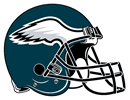
Well, what is there to say? If you plucked Vick off the waiver wire in 2010, there’s a strong possibility he carried you to a championship in your fantasy league. Simply put, he was the most dynamic fantasy player last season—averaging a remarkable 29.7 points per game—and the most dynamic fantasy quarterback over the course of a season ever. Consider the highest career PPG totals of the league’s other top fantasy quarterbacks: Tom Brady, 28.9; Peyton Manning, 26.7; Aaron Rodgers, 25.1; Drew Brees, 24.7. Vick came into his own in 2010, displaying an uncanny knack for big plays both with his arm and in the running game, where he rushed 100 times for 676 yards and nine touchdowns. Despite finishing fourth in yards per passing attempt, he completed a career-high 62.6 percent of his passes (his previous high was 54.6) and threw for 3,018 yards and 21 touchdowns with just six interceptions. If you’re looking for a knock on Vick, it’s that his refusal to avoid hits when carrying the ball caused him to miss three games to injury (he also sat out the season finale to rest for the playoffs). Consider Vick a top-five quarterback in redraft formats, although with a qualifier due to his injury risk.
McCoy proved he was the real deal in his first full year as the Eagles’ starter at running back. The 2009 second-round pick made Eagles fans forget Brian Westbrook and made his fantasy owners ecstatic, courtesy of his 1,080 rushing yards, 592 receiving yards, and nine touchdowns. That production vaulted McCoy into the top ten at running back, and he finished at eighth despite taking Week 17 off to rest for the playoffs. He was also remarkably consistent, reaching double-digit fantasy points in 12 of the 15 games he played. McCoy isn’t the fastest or most elusive running back in the league, but he possesses enough ability in both areas to be a dangerous runner. His pass-catching ability helps separate him from several of the other upper-tier running backs—as does the presence of quarterback Michael Vick. With Vick requiring a defensive spy and DeSean Jackson often double-teamed out wide, defenses can’t focus on McCoy. Because of that, he is a solid bet to duplicate his 2009 ranking with an outside chance of entering the top five, especially in PPR leagues.
The Mike Bell experiment didn’t last long in Philadelphia as he was shipped off to the Browns for another disappointing runner in Jerome Harrison. The change of scenery benefitted Harrison, however, as he seemed a more natural fit in Philadelphia than in Cleveland. In limited opportunities, he rushed for 330 yards, averaging 4.6 yards per carry, with one touchdown. If LeSean McCoy were to go down, Harrison would likely put up RB2 production as his replacement. The Eagles took Dion Lewis in the fifth round of this year’s draft, and he will battle Harrison for the backup spot. Monitor that situation and consider Harrison a decent handcuff option (but not an imperative one), provided he wins the job.
Picked in the second round of the 2008 draft, Jackson has since established himself as the premier pass catcher of his rookie class, with 3,124 receiving yards and 17 receiving touchdowns through his first three years in the league. The speedy Jackson is a highlight-reel playmaker, capable of scoring at any time from any position on the field. After finishing as the ninth-ranked fantasy wideout in 2009, his production dipped slightly in 2010 as he finished with 47 receptions for 1,056 and six touchdowns. The main reason for the drop was due to a concussion he received on a devastating hit from Falcons cornerback Dunta Robinson. That caused him to miss the rest of the game and the next two games as well. However, he also had fewer big plays last year, and that is one of the issues with Jackson’s fantasy production. While he is a big-play machine, he doesn’t catch many passes, which results in a number of games with low fantasy points. In 45 career games, Jackson has reached double-digit fantasy points just 17 times and has 18 games with five or fewer points. When he booms, he booms. When he busts, he busts. Jackson will be drafted as a WR1, but you need to ask yourself if you want to put up with the inconsistency he brings to the table.
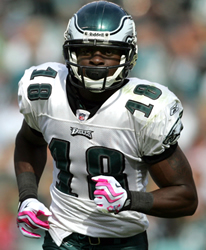 Jeremy Maclin: The Eagles top fantasy wideout in 2010.
Think fast! Who was the Eagles’ top fantasy producer at wide receiver last season? DeSean Jackson? Nah, it was Maclin. With 70 receptions for 964 yards and a whopping ten touchdowns, Maclin’s 160 fantasy points topped Jackson by three points and was good enough to place him 12th at wide receiver. Better yet, Maclin showed major improvement over his rookie season (when he caught 55 passes for 762 yards and four touchdowns) and figures to improve even more in his third season, the point at which many wide receivers take a big step forward. Add in the fact that the Jackson commands a healthy dose of double teams, leaving Maclin facing predominantly single coverage, and he seems like a sure bet to cement his 2011 status as a top-tier WR2 or perhaps a low-end WR1. While Jackson will go higher in fantasy redraft formats because of his superior skills and bigger reputation, Maclin will be the better value and is a far more consistent performer.
After signing a five-year contract extension prior to the 2010 season, Avant merely duplicated his 2009 production, catching 51 passes for 573 yards and a touchdown. Even though he had 16 more targets in 2010, he failed to capitalize on the increased opportunity as he suffered a case of the dropsies, including a couple of easy ones in the end zone. Entering 2011, he will battle second-year receiver Riley Cooper for playing time. Look for Avant to hold off Cooper, but it seems that a drop in production remains likely for Avant. Tight end Brent Celek figures to be more involved this season, and Cooper will nonetheless eat into Avant’s targets. Unless injuries strike DeSean Jackson or Jeremy Maclin, Avant is only worth owning in the larger leagues with deep rosters.
Celek entered 2010 coming off a breakout campaign in which he caught 76 passes for 971 yards and eight touchdowns—production that made him the fourth-ranked fantasy tight end in 2009. Things turned sour early in 2010, however, when quarterback Kevin Kolb was replaced by Michael Vick. Vick overlooked Celek early and often last season, leaving the talented pass-catching tight end as one of the biggest fantasy disappointments of the year. His production plummeted to 42 receptions for 511 yards and four touchdowns. Clearly, Celek benefitted in 2009 from playing with Donovan McNabb, who had made marginal talents such as Chad Lewis and L.J. Smith into solid producers at tight end. Heading into 2011, Celek’s prospects for a big rebound look remote. Vick is entrenched at quarterback and will have his favorite targets in DeSean Jackson and Jeremy Maclin back at wide receiver. Consider Celek worth taking a flier on only as a backup tight end.
 By: Mike Krueger — July 7, 2011 @ 10:54 am By: Mike Krueger — July 7, 2011 @ 10:54 am
Player Projections, Rankings & Cheatsheets
Change Log – 7/7
Quarterbacks
Running Backs
- Flip-flopped the projections for Tashard Choice (+7) & DeMarco Murray (-7). The more I consume on the Cowboys backfield, the more I think Choice wins the playing time battle with the rookie.
- Added John Kuhn (GB) and Alex Green (GB). Both had been projected but were left out in the last update.
- Delone Carter (IND) up, Javarris James (IND) removed.
- Slight decrease in Maurice Jones-Drew’s rushing yardage (-50) as I become increasingly skittish about his knee injury.
- Added a TD to the rushing totals of Ryan Mathews (SD).
Wide Receivers
Tight Ends
- Chris Cooley (-2) moves down until we get a better handle on who the QB is going to be.
- James Casey (+8) ranked too low in previous update.
 By: Dave Stringer — @ 10:19 am By: Dave Stringer — @ 10:19 am
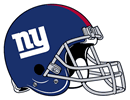
Do you get the feeling that Eli is the Rodney Dangerfield of fantasy quarterbacks? Rodney couldn’t get any respect and neither can Eli. After his breakout campaign in 2005 when he finished as the fourth-ranked fantasy quarterback (albeit in a soft year for production at the position), he fell to 11th, 13th, and 15th over the next three years. However, over the last two seasons, Manning has made it into the top ten, finishing seventh this past season and 10th in 2009. Yet despite his two consecutive 4,000-yard seasons and 58 touchdowns over that period, look for Eli to be rated as a bottom-tier starter in 12-team leagues heading into 2011. “He ain’t heavy, he’s my brother” might best sum up the respect Eli gets in fantasy circles. Clearly Manning’s production is due in part to his solid supporting cast, including one of the league’s best trios of wide receivers in Hakeem Nicks, Steve Smith, and Mario Manningham—along with a solid pass-catching running back in Ahmad Bradshaw and a serviceable tight end in Kevin Boss. Look for the Giants to bring back that same supporting cast on offense, although Smith is a question mark because of the microfracture surgery he needed to repair the knee injury he suffered midway through last season. Considering his propensity for giving the ball away (25 interceptions and five fumbles in 2010), move Manning down in leagues that penalize turnovers, but consider him a decent option just outside the big six at quarterback.
Last year Bradshaw won the training camp battle against incumbent starter Brandon Jacobs and proceeded to have a solid season for the Giants. The former seventh-round pick produced career highs in rushing yards (1,235), receiving yards (314), and touchdowns (8), finishing 13th overall at running back. The only black mark on his season was his six fumbles, which caused head coach Tom Coughlin to relegate him to backup status from Week 12 to 16. The Giants have become more of a passing team over the last two seasons, and that virtually ensures that Bradshaw will remain the starter due to Jacobs’ inability to catch the ball. Bradshaw enters 2011 as a mid-tier RB2 with upside and with a mild amount of risk due to his fumbling issues.
Jacobs enters 2011 coming off a pair of subpar fantasy seasons. He was injured and largely ineffective in 2009 and then lost his starting position to Ahmad Bradshaw last season. Jacobs was a rising fantasy star after posting consecutive 1000-yard seasons in 2007 and 2008 as well as putting up 15 touchdowns in 2008. However, Bradshaw appears to be firmly entrenched as the starter, so the prospect of Jacobs emerging as a fantasy stud appears to be over. While his fantasy stock has taken a hit, he remains a solid RB3 and a great flex option in leagues that employ the position. Despite losing his starting position, he still managed to average 8.9 points per game—a drop of only 0.3 from 2009—with 882 total yards and nine touchdowns. In addition, he has only missed one game over the last two seasons, putting to rest the injury concerns that plagued him earlier in his career. He also raised his yards per carry from 3.7 in 2009 to 5.6 last season. Add it all up and he might provide value on draft day.
After a solid rookie campaign, Nicks entered 2010 on the verge of overtaking Steve Smith as Manning’s go-to receiver. Sure enough, he blasted out of the gates with a four-reception, 75-yard, three-touchdown performance against the Panthers in Week 1. From there, Nicks went on to establish himself as the team’s top receiving threat, having an outstanding sophomore season with 79 receptions for 1,052 yards and 11 touchdowns, despite missing two games with injuries. Entering 2011, Nicks has the potential to become one of the top five receivers in the league due to his impressive combination of size, speed, and route-running ability, although he is still prone to the occasional drop. With Steve Smith likely to suffer a dip in production courtesy of offseason microfracture surgery, look for Nicks to see a big increase from the 128 targets he had in 2010. Because of that, he is a solid bet to finish in the top ten at wide receiver, and a top-five ranking would come as no surprise.
Smith burst onto the scene in 2009, finishing the year with 107 receptions (the most in team history) for 1,220 yards and seven touchdowns. With the Giants moving to more of a pass-based offense, more of the same was expected last season. However, Smith caught the injury bug, suffering a torn pectoral muscle that caused him to miss four games, only to return and suffer a season-ending knee injury in Week 14. Even when he was in the lineup, his production was down, with his point-per-game average slipping from 10.3 to 7.9. With Mario Manningham developing into a big play receiver and Smith’s recovery from microfracture surgery uncertain—and a stint on the PUP to open the season not out of the question—he ranks as a backup wide receiver at best in 2011. And don’t forget that he’s a better option in PPR leagues than in standard scoring formats.
After washing out during his rookie season in 2008, Manningham finished as the 28th-ranked fantasy wide receiver in 2009 and then improved upon that in 2010, finishing 15th. He became better in every area last season, finishing with 60 receptions for 944 yards and a healthy nine touchdowns, which were all career highs. What is even more impressive is that he managed that with only 92 targets while catching 65.2 percent of those targets—a very high percentage considering he finished the year averaging 15.7 yards per reception. With Steve Smith coming off a knee injury and Manningham having shown major improvement over the past two years, he is a breakout candidate in 2011. Look for Manningham to open the season in the starting lineup and relegate Smith to a backup role. There isn’t anything to suggest he can’t finish as a WR2 again in 2011, especially since he should see the ball more. He will likely be a bargain on draft day.
Entering his fifth season in the league, it appears that the mold has been set for Boss’s offensive production. Basically, it’s touchdowns, touchdowns, touchdowns. He doesn’t catch a lot of balls (42 is his career-high), he doesn’t get a lot of yards (a career-high of 567), and he’s wildly inconsistent with 19 games of five fantasy points or fewer in his 30 games over the last two seasons. However, he has 16 touchdowns over the past three seasons and has scored at least five every year. Entering 2011, there may be more opportunities for Boss to produce with Steve Smith recovering from a knee injury. He will need to hold off third-year player Travis Beckum for the starting nod, but that appears likely. Boss is clearly a TE2 with little upside and ranks as a mid-tier backup.
 By: Dave Stringer — July 5, 2011 @ 3:07 pm By: Dave Stringer — July 5, 2011 @ 3:07 pm
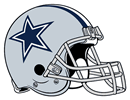
After finishing as a top-five fantasy quarterback in 2009, Romo gave his owners high expectations entering 2010 that were dashed with a broken clavicle that ended his season in Week 6 and also put the team’s playoffs hopes to bed. That’s the bad news. The good news is that Romo was having a solid campaign before he was injured, averaging 21.3 points per game, a very slight decline from the 22.3 points per game he averaged from 2007 through 2009. Although there are questions along the offensive line, the Cowboys figure to return all of their key passing weapons from a year ago and are expecting major improvement from 2009 first-round pick Dez Bryant. Add it all up and Romo is a solid bet to finish with 4,200 yards and close to 30 touchdowns. That should be enough to finish just outside of the big six at quarterback.
The Cowboys’ depth chart at running back has been in flux for much of the offseason, with Jones’ fantasy prospects along for the ride. On the plus side, the Cowboys are very likely to release Marion Barber, who was Jones’ main competition for the starting position. On the down side, the team chose DeMarco Murray in the third round of the draft with the expectation that he will assume Barber’s role in the backfield. While competing with a rookie for touches is preferable to competing with an established veteran, the bottom line is that Murray’s selection is a clear signal that the team does not consider Jones a candidate to assume a big workload, despite the fact that he finished with career highs in rushing yards (800), receiving yards (450), and receptions (48). Murray’s presence will once again make the Cowboys backfield a running-back-by-committee approach, with Tashard Choice also in the mix. Jones is clearly a talented runner who possesses blazing speed, but that hasn’t translated into consistent production. Entering his fourth season, this is likely Jones’ last chance to prove his worth as a starter in Dallas. With Murray on board to steal goal line touches, Jones’ touchdown production (eight through his three years in the league) isn’t likely to rise, and neither is his 26th ranking from last season. There’s basically no reason to expect a breakout campaign from Jones in 2011, and that makes him a RB3 with little upside.
The Cowboys like to employ at least one bruising back, and with Marion Barber suffering a major decline in production last season, the team used a third-round draft pick on Murray. He is a similar player to Barber, but with more speed and less size, making him a better option than veteran Tashard Choice to win the backup role behind Felix Jones. Murray unfortunately had injury issues at Oklahoma, so we’ll have to wait to see how well he handles the pounding at the pro level. But given Jones’ injury history and the Cowboys’ reluctance to give a meaningful opportunity to Choice, Murray has intriguing fantasy potential. At worst, he wins the short-yardage and closer role. At best, he ends up getting significant touches as Jones’ misses time. He is a must-have as a handcuff to Jones and worth grabbing as one of the first backups off the board at running back.
Personally, I like Choice. I’m just not too sure the Cowboys feel the same way. With Felix Jones and Marion Barber in the fold, Choice was clearly the team’s third option at running back. Barber is expected to leave, but the team drafted a replica of him in the third round in DeMarco Murray. Expect Choice to be the fallback option once again in 2011. He has been productive when given an opportunity, as evidenced by his double-digit fantasy points in four of the five games in which he has received 15 or more touches. However, his likely status as the third-string running back in Dallas makes him waiver wire material in all but the deepest leagues.
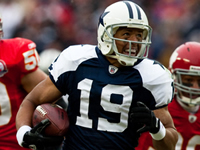 Austin will be happy to see Romo under center in 2011.
After having a breakout season with 1,320 yards and 11 touchdowns in 2009, Austin was a bit of a disappointment last season even though he remained productive. Despite losing Tony Romo at quarterback, Austin still managed to haul in 69 passes for 1,041 yards and seven touchdowns—good enough to finish as the 17th-ranked fantasy wide receiver. However, more was expected from him since he was ranked in the top ten by nearly every fantasy prognosticator. With Romo back in the saddle, Roy Williams clearly an afterthought, and Dez Bryant displaying some offseason difficulties, Austin is in line for another big season in 2011. In the five full games Romo played, Austin had three games of double-digit targets and fantasy points (averaging 12.1) with more than 100 receiving yards in each of those games. For 2011, he shapes up as a high-end WR2 with upside and the possibility of replicating his top-five fantasy ranking from 2009.
The talent is there. The opportunity is there. But is Bryant’s production going to get there, too? Tough question. The Cowboys gambled on Bryant, using the 24th pick in the 2010 draft on a player who likely had top-five talent. As a rookie last season, he displayed his big-play ability both in the passing game and as a returner, finishing the year with 45 receptions for 561 yards and six touchdowns plus a pair of punt return touchdowns, all despite missing four games with a broken leg. However, many of his targets were on screens and short passes, which created the lingering suspicion that he failed to grasp the playbook. That potential issue, made worse by a shortened offseason (as well as his offseason problems and the petulance he displayed at times as a rookie) increase his risk and make the odds of his having a breakout season in 2011 somewhat remote. That being said, he is a gifted player capable of being one of the top five wide receivers in the league. Just don’t bank on that happening this season. Look for Bryant to be a WR3 in 2011, but a player with significant upside.
Has a wide receiver with more talent ever accomplished less than Roy Williams? It is hard to think of one. The light has never fully gone on for the big, fast and reasonably shifty Williams, who has topped 1,000 receiving yards just once in his seven seasons in the league. And he hasn’t gone over 600 yards in any of the past three seasons, although his fantasy production has been padded by the 14 touchdowns he has scored over that span. Williams will turn 30 during the 2011 season, and while that isn’t a huge issue for many receivers, it’s just another reason to avoid this major disappointment.
Entering 2010, Witten’s fantasy reputation was as a player who gained significant yardage year in and year out but who failed to find the end zone on a regular basis, with just six touchdowns combined over the 2008 and 2009 seasons. He put that to rest last season, scoring a career-high nine touchdowns to go along with 94 receptions (for the second year in a row) and 1,002 yards, good enough to make him the top-ranked fantasy tight end. For 2011, the only red flag on Witten is that he caught just two of his nine touchdowns during the six games that Tony Romo started. Ignore that, however, since Witten has topped 90 receptions and 1,000 yards in three of the last four seasons, chalking up 81 receptions for 952 yards in a “down” year in 2008. He’s money and ranks behind only Antonio Gates for 2011.
 By: Dave Stringer — July 1, 2011 @ 1:58 pm By: Dave Stringer — July 1, 2011 @ 1:58 pm
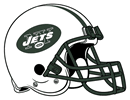
Sanchez has had an interesting two-year run as the Jets’ starting quarterback. Since being taken with the fifth pick in the 2009 draft, he has led the jets to the AFC Championship Game twice, losing both times. Despite that success, he hasn’t received the acclaim one would expect from such a successful start to his career. On the fantasy side, Sanchez improved from the 23rd-ranked quarterback in 2009 to 18th last season, a tidy five-place jump. Nonetheless, that’s still backup status, and there isn’t a lot of evidence to suggest that another significant jump is in the cards for 2011. The Jets are a run-first team that features a quality group of receivers and a good pass-catching tight end in Dustin Keller. The offensive philosophy is based on taking few risks and not turning the ball over. While Sanchez improved his yardage total from 2,444 to 3,291 and his passing touchdowns from 13 to 17, his outlook for 2011 remains that of a fantasy backup.
With Thomas Jones out of the picture and LaDainian Tomlinson expected to assume the role of a third-down specialist and change-of-pace back, much was expected of Greene last year. And he flopped. Big time. Greene was drafted in some leagues as a low-end RB1 with upside, but he finished as the 37th-ranked running back in leagues with standard scoring. Removing running backs who can’t blame their poor production on injuries, Greene was likely the biggest fantasy bust at the position in 2010. But 2011 is a new year and a time for redemption. Tomlinson is a year older and Joe McKnight was so bad as a rookie last year that the Jets drafted Bilal Powell in the fourth round to challenge him. Greene figures to take over as the starter—if not on opening day, then sometime in 2011—and there is a strong possibility he will have a solid fantasy season. The team’s offensive line remains perhaps the best run-blocking unit in the league, and the offensive philosophy will be based heavily on the run. If Greene opens the season as the team’s starter, he figures to be a low-end RB1. If not, draft him as a RB2, but one with considerable upside if he can win the starting job by mid-season.
Well, I told you last year “those of you out there looking for a return to glory for LT in New York, you can think again.” And this year, I’m telling those of you out there expecting a repeat of last year’s return to glory, you can think again. LT was great last season, having a renaissance year with 914 rushing yards, a healthy 4.2 yards per carry, 52 receptions for 355 yards, and six total touchdowns. That placed him as the 18th-ranked fantasy back and provided excellent value to his owners, most of whom grabbed him with a low-round draft pick. That’s the good news. The bad news is that it was a tale of two seasons for LT as he basically hit a brick wall late in the year. He scored just one touchdown in his final nine games and averaged a measly 6.7 points per game in his last five games. From Week 6 on, he averaged only 3.3 yards per carry. At 31, LT is headed for backup status; but in a Jets offense that loves to run, he ranks as an upper-tier backup in 12- and 14-team leagues as well as a nice option in flex leagues.
After his 2007 breakout season in Cleveland in which he caught 80 passes for 1,289 yards and 16 touchdowns, Edwards struggled mightily over the next two years, catching just 90 passes for 1,557 yards and seven touchdowns. Despite showing inconsistent hands at times, he had a bit of a renaissance in 2010, becoming a big-play threat for the Jets while making 53 receptions for 904 yards and seven touchdowns. Fantasy-wise, Edwards’ production dropped when Santonio Holmes returned from a four-game suspension. With Holmes in the lineup, Edwards’ fantasy points per game dropped from 10.2 to 7.6. In New York, Edwards won’t be the featured receiver, with a large part of his role being that of a deep threat. That makes him a WR3 at best in 2011.
There’s not much to dislike about Holmes’ game. He has reliable hands and the speed to get deep. He can turn slants and crossing patterns into big plays. While he has never had a true breakout season, topping 1,000 yards only once in five years and never catching more than eight touchdown passes in a single season, the issue has usually been lack of opportunity, not talent. In Pittsburgh, he mostly played second fiddle to Hines Ward. Last season in New York, he missed the first four games of the season because of a suspension and then he was saddled with playing in a run-based offense that topped 200 passing yards in just six of the 12 games in which he played. Because he’ll be available for all 16 games and have another year in the Jets’ offensive system under his belt, Holmes figures to up his production in 2011. However, another sub-1000-yard season and five or six touchdowns seems most likely. That makes him a high-end WR3 in most leagues.
With Santonio Holmes and Braylon Edwards in the fold, Cotchery will be relegated to the role of fill-in starter and to playing on obvious passing downs, meaning his days as a fantasy starter are clearly over. In fact, Cotchery didn’t even perform well when given an opportunity in 2010, catching just 47.7% of his targets—by far the worst performance in that category in his career. For further evidence of his demise, look to how his yardage totals have dropped in each of the last three years to just 433 last season. Summing it up, he’s a player on the decline playing as a backup in an offense that prefers to run. You can do better.
Over the last two years, Keller has been a reliable, albeit unspectacular, tight end for the Jets, which is somewhat of a disappointment after his impressive rookie campaign in 2008. He is coming off of a career year in 2010 when he finished the season with 55 receptions for 687yards and five touchdowns. Looks good until you dig a little deeper. First off, he caught just 54.5% of his targets, and this percentage has dropped over each of the past two seasons. Secondly, 55 of his 98 fantasy points and all five of his touchdowns came in the first four weeks of the season. Over the remaining 12 games of the year, he averaged a paltry 3.6 points per game. And that’s because once Santonio Holmes returned from a four-game suspension, Keller’s role in the Jets offense was reduced. With Holmes on board for 2012, look for Keller to produce as a TE2.
 By: Dave Stringer — June 30, 2011 @ 2:06 pm By: Dave Stringer — June 30, 2011 @ 2:06 pm
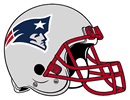 Outside of his magical 2007 season when he threw for nearly 5,000 yards and 50 touchdowns, Brady was never better than he was in 2010. Despite losing the team’s projected top receiver and only true deep threat, Randy Moss, in an early-season trade and being left with a group of merely average receivers, Brady threw for 3,900 yards and 36 touchdowns with a career-low four interceptions. He easily adapted to Moss’ departure, with the offense moving from an air-it-out to more of a dink-and-dunk approach. Considering what he accomplished last year with a lackluster receiving corps, Brady is essentially a guarantee to produce at quarterback. With talented tight ends Rob Gronkowski and Aaron Hernandez entering their second seasons and with the team hopeful that either Brandon Tate or Taylor Price can scare defenses a little on the outside, Brady should at least match his strong season from a year ago. Outside of his magical 2007 season when he threw for nearly 5,000 yards and 50 touchdowns, Brady was never better than he was in 2010. Despite losing the team’s projected top receiver and only true deep threat, Randy Moss, in an early-season trade and being left with a group of merely average receivers, Brady threw for 3,900 yards and 36 touchdowns with a career-low four interceptions. He easily adapted to Moss’ departure, with the offense moving from an air-it-out to more of a dink-and-dunk approach. Considering what he accomplished last year with a lackluster receiving corps, Brady is essentially a guarantee to produce at quarterback. With talented tight ends Rob Gronkowski and Aaron Hernandez entering their second seasons and with the team hopeful that either Brandon Tate or Taylor Price can scare defenses a little on the outside, Brady should at least match his strong season from a year ago.
BJGE came out of nowhere to have a breakout season in 2010. The former undrafted free agent had 1,008 rushing yards, becoming the team’s first 1000-yard running back since Corey Dillon in 2004. He proved to be an effective closer and short-yardage back with his 13 touchdowns, helping him to a 15th place fantasy ranking at running back. And what was his reward for such a respectable season? Watching the team draft running backs in the second and third rounds of this year’s rookie draft. Of those rookies, Stevan Ridley is Green-Ellis’ main threat, given his size and potential as a short-yardage runner. Green-Ellis is certainly not the most talented back in the league, but he figures to earn the most playing time given his strong season, his ability to hold on to the ball (no fumbles in the regular season), and his pass-blocking ability. The team’s coaching staff isn’t going to give much playing time to the rookies until they have proven they can protect their marquee quarterback. There are clearly doubts about BJGE’s fantasy stock in 2011, but he is worth gambling on as a low-end RB2 or upper-tier backup.
If there’s one thing the Patriots have proven over the years, it’s that they can take other teams’ castoffs and make them productive players if they fit the New England system. There were plenty of heads shaking in New York when the Patriots turned former Jets running back Danny Woodhead into a serious backfield threat for much of 2010. Woodhead arrived in New England in time for opening day and took over for Kevin Faulk as the pass-catching and change-of-pace back in Week 3. Generously listed at 5’8” and 195 pounds, Woodhead ran for 547 yards and five touchdowns on just 97 carries while chipping in 34 receptions for 379 yards and another score. You would figure healthy averages of 5.6 yards per carry and 11.1 yards per reception would earn you significant playing time the following season, but Woodhead will battle with the Patriots’ second-round pick, Shane Vereen, for playing time. It’s unlikely Vereen will win the job by opening day, which means Woodhead will have an opportunity to solidify his position on the roster. Expect more of the same from Woodhead in 2010 and draft him as a high-end RB4 who should prove useful as a flex player.
The Patriots were clearly looking for quality competition for Green-Ellis and Woodhead when they took Vereen in the second round and Stevan Ridley in the third. In his rookie year, Vereen shapes up as a competitor to Woodhead as a pass-catching, change-of-pace back; but he’s an intriguing option in dynasty leagues given his overall skill set. A tad undersized at 5’10” and 210 pounds, Vereen could emerge as the Patriots’ lead back in the next year or two. He is unlikely to win extensive playing time by opening day, but he could gain touches as the season goes on. Keep your eye on him in training camp, but at this point he is most likely to be waiver wire material early in the season. In dynasty leagues, he is definitely worth grabbing, given the strong state of the Patriots offense.
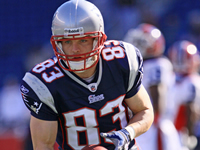 Welker scored double-digit fantasy points in only 5 games last season.
Entering 2011, Welker has a laundry list of both positive and negative issues that affect his fantasy prognosis. On the plus side, he is now a year and a half removed from the surgery that ended his 2009 season, he is clearly the Patriots top wide receiver, and he was a significant weapon in 2010 with 86 receptions for 848 yards and seven touchdowns, which were the second most of his career. The flip side is that he caught 69.9 percent of his targets (down from 75.9 percent for the 2007-2009 period), his reception total was down 30 from his average over the previous three seasons, his yards per reception was the lowest of his career, and he had only five games with double-digit fantasy points. Welker turned 30 in the offseason, and while that usually isn’t a big issue for receivers, it could be for a small player who relies on his quickness and cutting ability to get open. The question is whether his drop in production was mainly the result of his knee injury or whether it was because defenses gave him additional attention with Randy Moss no longer in the lineup. With no proven deep threat on the roster, Welker figures to get plenty of attention again in 2011, so expecting him to bounce back to his 2007-2009 production is not very realistic. Draft Welker as a low-end WR2. He no longer has the upside to achieve WR1 status.
Quick—who is the New England wide receiver to own in 2011? Wes Welker, right? Not so fast. While Welker may bounce back from a bit of a down year, Branch was surprisingly solid for the Patriots after he was acquired from the Seahawks prior to Week 6 last season. In the 11 games in which Welker and Branch were both in the lineup, Branch had 101 fantasy points to Welker’s 87. However, Branch was definitely the more inconsistent of the two players, with less than five fantasy points in the 11 games he played with the Patriots. He will open the season starting opposite Welker, and he figures to roughly duplicate his 2010 production of 61 receptions for 818 yards and six touchdowns. That makes him a low-end WR3, but he will be drafted far lower than Welker in 2011 and should therefore provide excellent value. If you’re looking to get a piece of the New England offense on the cheap, Branch might be your guy.
The Patriots have been waiting patiently for Tate to produce after taking him in the third round of the 2009 draft. So far, they have little to show for their investment. Tate has been a good kick returner, displaying nice moves and the speed that saw him move up draft boards in 2009. However, he has been inconsistent as a receiver and was only marginally useful in 2010 with 24 receptions for 432 yards and three touchdowns. He enters his third year in the league this season, but there is little reason to think he is ready for a breakout year. With a pair of veteran wide receivers ahead of him on the depth chart, two heavily targeted tight ends, and a pair of pass-catching running backs, Tate doesn’t figure to get much more than the occasional deep target in 2010.
Hernandez was a revelation as a rookie early in 2010, busting out of the gate with 34 receptions for 406 yards and a pair of touchdowns over his first eight games. However, a suspected hip injury that caused him to miss the final two games of the season may have caused his second-half stumble, as he caught just 11 passes for 145 yards over the final part of the season—although his four touchdowns over that stretch made his fantasy point total respectable. Fellow rookie Rob Gronkowski emerged as quarterback Tom Brady’s favored option at tight end, but Hernandez has more upside given his ability to stretch the field. Look for Hernandez to win the receiving yardage battle but for Gronkowski to catch more touchdowns in 2011. Draft Hernandez as a mid-tier starting tight end with upside, but as one with an injury risk due to offseason hip surgery.
Gronkowski started slowly in his rookie season in 2010, with just two multi-reception games over the first seven weeks. From that point on, he gained the trust of the coaching staff and earned a greater role in the offensive game plan because of his soft hands and ability to get open on short and intermediate routes. By season’s end, Gronkowski had emerged as a top-ten fantasy producer at tight end, finishing with 42 receptions for 546 yards and a whopping ten touchdowns. Replicating his touchdown count in 2011 seems unlikely if fellow second-year player Aaron Hernandez remains healthy, so Gronkowski enters 2011 as an upper-tier TE2 with upside if he can relegate Hernandez to more of a third-down role.
 By: Dave Stringer — June 29, 2011 @ 1:35 am By: Dave Stringer — June 29, 2011 @ 1:35 am
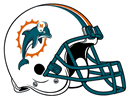 Henne’s fantasy stock was on the rise entering 2010 after the Dolphins traded for Broncos wide receiver Brandon Marshall. The acquisition of Marshall provided Henne with a true number one wide receiver for the first time. With another year under his belt, a solid running game, and Marshall opening up defenses, Henne seemed like a sound bet to have a productive season under center for Miami. Unfortunately for Henne’s owners, he failed to take advantage of the situation and had a disappointing season, throwing for just 3,301 yards with 15 touchdowns and 19 interceptions. He enters 2011 knowing it is a pivotal year in his career. The 2008 second-round pick’s contract is up after the season and he knows this will be his last chance to solidify the starting position in Miami. While he will be motivated, we don’t like his chances of having a breakout season. Henne’s prospects of developing into a fantasy starter are slim, and he fits in as a low-end fantasy backup with little upside. Henne’s fantasy stock was on the rise entering 2010 after the Dolphins traded for Broncos wide receiver Brandon Marshall. The acquisition of Marshall provided Henne with a true number one wide receiver for the first time. With another year under his belt, a solid running game, and Marshall opening up defenses, Henne seemed like a sound bet to have a productive season under center for Miami. Unfortunately for Henne’s owners, he failed to take advantage of the situation and had a disappointing season, throwing for just 3,301 yards with 15 touchdowns and 19 interceptions. He enters 2011 knowing it is a pivotal year in his career. The 2008 second-round pick’s contract is up after the season and he knows this will be his last chance to solidify the starting position in Miami. While he will be motivated, we don’t like his chances of having a breakout season. Henne’s prospects of developing into a fantasy starter are slim, and he fits in as a low-end fantasy backup with little upside.
With the aging duo of Ronnie Brown and Ricky Williams having substandard seasons in 2010 and sitting on expiring contracts, the Dolphins traded up to take Kansas State’s Daniel Thomas in the second round, dealing three of their draft picks to get him. The bruising 6’0”, 230-pound runner enters a great situation in Miami and figures to have the inside track on opening the season as the starter. He was highly productive running the ball at Kansas State and he can contribute in the passing game as well. Given his opportunity, Thomas is in a virtual dead heat with the Saints’ Mark Ingram to be the top rookie running back taken in redraft formats, and he likely ranks behind only Ingram in dynasty rookie drafts. He enters the season as a low-end RB2 or high-end RB3 with upside.
With his trade to the Dolphins prior to the 2010 season, Marshall brought considerable talent to the passing game in Miami. Unfortunately, he also brought a considerable amount of baggage—and he has proceeded to add to it. The Dolphins knew in advance how that equation works, but Marshall, while having a solid year by most standards, had his worst season since his breakout campaign in 2007. After totaling 307 receptions for 3,710 yards and 23 touchdowns during his final three years in Denver, his production plummeted to 86 receptions for 1,014 yards and a measly three touchdowns in Miami. The low touchdown total caused him to drop to 27th in the wide receiver rankings after finishing no worse than 11th over the previous three seasons. Worse yet, he pouted both on and off the field about his role, despite having just eight fewer targets (in one fewer game played) in 2010 than in 2009. Marshall is a big name who will be drafted as a WR1, but there are better options out there that carry far less risk (considering Marshall’s attitude and his quarterback). Buyer beware.
He’s not that big, not that fast, and not exactly the shiftiest receiver in the league. No matter, all Bess does is get open and move the chains, earning the trust of the Dolphins coaches and, more importantly for his fantasy owners, plenty of targets. He has improved his numbers in each of his three years in the league and enjoyed a career year in 2010 with 79 receptions for 820 yards and five touchdowns, all career highs. Considering his penchant for plenty of receptions but not many big plays, Bess is a player whose ranking depends on your league’s scoring system. In redraft formats, he is clearly a WR4 or low-end starter. In point per receptions leagues, he is a solid WR3. Given his lack of star power and the dearth of big plays he provides, he should be a bargain on draft day.
Hartline emerged as the Dolphins’ starting wide receiver opposite Brandon Marshall last year but failed to capitalize on the opportunity. Despite having the talented Marshall opposite him and seeing his targets increase from 56 to 73, Hartline registered minimal improvements in receptions (31 to 43) and receiving yards (506 to 615) while suffering a drop in touchdowns (three to one). Although the 2009 fourth-round pick is entering his third season, a breakout seems highly unlikely given his marginal skill set. On a Dolphins team that would prefer to feature the run more than they did in 2010, Hartline is the third option in the passing game behind Marshall and slot receiver Davone Bess. In fact, it wouldn’t be a surprise if 2011 fourth-round pick Edmond Gates emerges as the starter by midseason.
Fasano enters 2011 coming off of career highs in both receptions (39) and receiving yards (528). Still, his best fantasy season came in 2007 when he padded his fantasy point total with seven touchdowns. Entering his sixth season in the league, Fasano isn’t a player who is about to emerge as a solid pass-catching tight end, nor is he likely to catch a pile of touchdowns with Brandon Marshall in the lineup. He’s a low-end TE2 with little potential. Better to take a flier on a younger tight end who has some upside.
« Newer Posts — Older Posts »
| |
|
Powered by
WordPress |
|

|
 QB John Beck
QB John Beck






 Outside of his magical 2007 season when he threw for nearly 5,000 yards and 50 touchdowns, Brady was never better than he was in 2010. Despite losing the team’s projected top receiver and only true deep threat, Randy Moss, in an early-season trade and being left with a group of merely average receivers, Brady threw for 3,900 yards and 36 touchdowns with a career-low four interceptions. He easily adapted to Moss’ departure, with the offense moving from an air-it-out to more of a dink-and-dunk approach. Considering what he accomplished last year with a lackluster receiving corps, Brady is essentially a guarantee to produce at quarterback. With talented tight ends Rob Gronkowski and Aaron Hernandez entering their second seasons and with the team hopeful that either Brandon Tate or
Outside of his magical 2007 season when he threw for nearly 5,000 yards and 50 touchdowns, Brady was never better than he was in 2010. Despite losing the team’s projected top receiver and only true deep threat, Randy Moss, in an early-season trade and being left with a group of merely average receivers, Brady threw for 3,900 yards and 36 touchdowns with a career-low four interceptions. He easily adapted to Moss’ departure, with the offense moving from an air-it-out to more of a dink-and-dunk approach. Considering what he accomplished last year with a lackluster receiving corps, Brady is essentially a guarantee to produce at quarterback. With talented tight ends Rob Gronkowski and Aaron Hernandez entering their second seasons and with the team hopeful that either Brandon Tate or 
 Henne’s fantasy stock was on the rise entering 2010 after the Dolphins traded for Broncos wide receiver Brandon Marshall. The acquisition of Marshall provided Henne with a true number one wide receiver for the first time. With another year under his belt, a solid running game, and Marshall opening up defenses, Henne seemed like a sound bet to have a productive season under center for Miami. Unfortunately for Henne’s owners, he failed to take advantage of the situation and had a disappointing season, throwing for just 3,301 yards with 15 touchdowns and 19 interceptions. He enters 2011 knowing it is a pivotal year in his career. The 2008 second-round pick’s contract is up after the season and he knows this will be his last chance to solidify the starting position in Miami. While he will be motivated, we don’t like his chances of having a breakout season. Henne’s prospects of developing into a fantasy starter are slim, and he fits in as a low-end fantasy backup with little upside.
Henne’s fantasy stock was on the rise entering 2010 after the Dolphins traded for Broncos wide receiver Brandon Marshall. The acquisition of Marshall provided Henne with a true number one wide receiver for the first time. With another year under his belt, a solid running game, and Marshall opening up defenses, Henne seemed like a sound bet to have a productive season under center for Miami. Unfortunately for Henne’s owners, he failed to take advantage of the situation and had a disappointing season, throwing for just 3,301 yards with 15 touchdowns and 19 interceptions. He enters 2011 knowing it is a pivotal year in his career. The 2008 second-round pick’s contract is up after the season and he knows this will be his last chance to solidify the starting position in Miami. While he will be motivated, we don’t like his chances of having a breakout season. Henne’s prospects of developing into a fantasy starter are slim, and he fits in as a low-end fantasy backup with little upside.